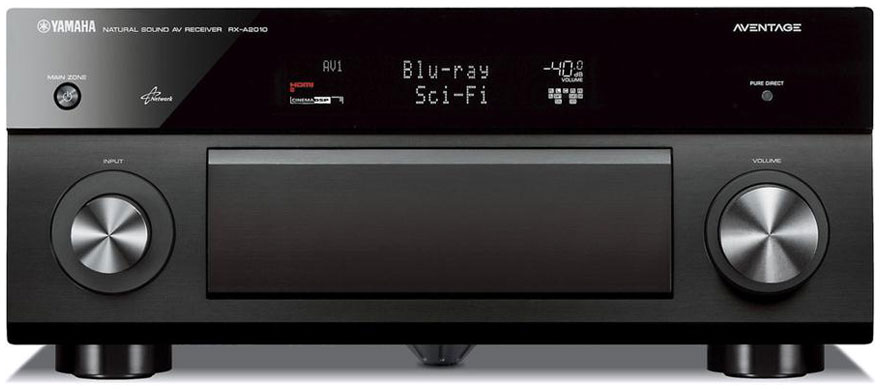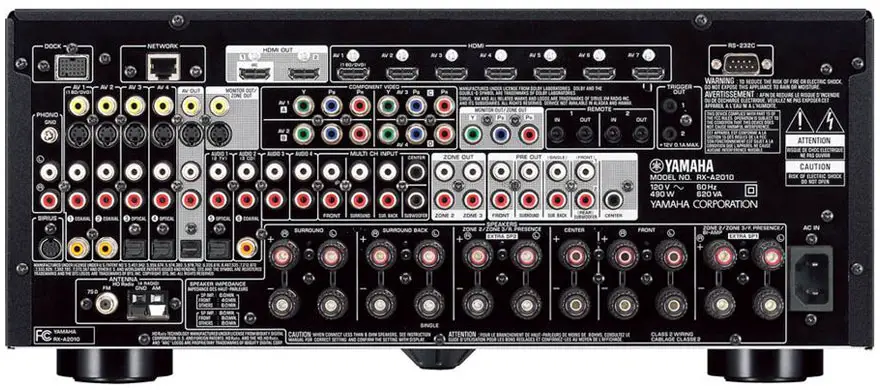Getting that cinematic feeling is all about setting up speaker configurations with as many speakers as possible. 5.1 and 7.2-channel configurations are quite common in home theater configurations because they yield exceptional sound quality. But if you have a larger room that needs sound reinforcement, you will notice considerable differences if you go for larger setups like a 9.2-channel speaker system. But in order to have this kind of setup, you should make your next home theater receiver actually supports 9.2-channel systems. High-end AV receivers like the Yamaha RX-A2010 provide enough wattage to handle the biggest home theater systems and also provide exclusive technologies that separate these receivers from the other Yamaha receivers in the AVENTAGE lineup.

Design
The RX-A2010 clearly shows its high-end nature by hiding all of the front panel ports behind a sleek aluminum door. The rest of this home theater receiver is pretty much built the same way because it is necessary for all the delicate circuitry to be properly protected. This aluminum build makes sure any energy buildups do not damage these internal components. To further stabilize the AV receiver added a special fifth foot to the center of the receiver to counter any damage and sound distortions caused by vibrations. There is even a name for this technology which is the Anti-Resource Technology (A.R.T.) Wedge because this foot has a different design than the other four feet. Combined H-shaped cross member frame, even high volume outputs do not cause any negative side effects to the receiver.

Features
Although the Yamaha RX-A2010 is really meant for serious home theater enthusiasts, the graphical user interface pretty much resembles the entry-level AVENTAGE models so configuring your massive home theater setup should be just as easy. It features a simple menu navigation system along with a friendly auto setup that gives you an idea on how your 9.2-channel system should be setup and where you should be when you calibrate the system.
Microphone-aided calibration systems are common amongst home theater receivers and the RX-A2010 uses a special calibration system of its own called YPAO to achieve the best sound optimization for the setup. But unlike the low-end AVENTEGE models, the RX-A2010 also features Reflected Sound Control to handle reflections to bring up the sound quality to studio levels.
There are a total of 8 HDMI inputs which pretty much opens the possibility in setting up very large home theater systems that can fully take advantage of the multi-speaker configurations. All of the ports support HDMI 3D passthrough so newer devices that support 3D features like Blu-ray players and 3D HDTVs so a third dimension can be added to the cinema-quality visuals if the media supports it. If you only have DVD players or other analog devices to connect to the RX-A2010, you can take advantage of the video scaling feature if you use HDMI as the connection so those visuals can maximize your TV’s resolution. You can also connect a display and a projector to the Yamaha RX-A2010 at once since there are 2 HDMI outputs.
Like other AVENTAGE receivers, the RX-A2010 has a solid set of network functions that can greatly benefit your home theater system especially if your media player or TV lacks Internet connectivity. By plugging an Ethernet cable to the RX-A2010, you can use it to listen to Internet radio or Sirius XM. Popular online services like Napster, Rhapsody, and Pandora are officially supported in this receiver.
The Yamaha RX-A2010 will also be part of your network so you can configure or manipulate the player through the Web Browser Control. You can also use an iPad, iPhone, or Android smartphone to download the AV Controller App so you can use your mobile device to control the AV receiver If you decide to plug in the iPhone or even the iPod to the USB port instead, you can play your MP3 tracks from there and enjoy the enhanced sound quality brought out by the RX-A2010.
The RX-A2010 has a rated output power of 155 watts but it does not forgo the eco-friendly standards set by Yamaha in the design stages. Power consumption is reduced to just 2.7 watts in HDMI Standby Through mode or 0.3 watts in standby mode. The Auto Power Down feature also saves energy in case you forgot to turn off the RX-A2010. You can set the RX-A2010 to turn off automatically after 4, 8, or 12 hours.
Below is the back panel layout. Click on image to enlarge for a clearer view.

Performance
The Blu-ray title, Sting Live in Berlin is a great disc to test if the RX-A2010 is up to the make in video and audio performance. Right from the opening track “A Thousand Years” it was obvious that the sharpness and level of details were really good, from the faces of the musicians all the way down to the textures of the shirts they were wearing. The DTS-HD Master Audio 5.1 soundtrack brought out the raw quality in Sting’s voice as well as the lyrical nuances of Branford Marsalis’ saxophone with the strings of the Royal Philharmonic providing subtle cues of the hall ambience. The audio quality was even better when CINEMA DSP 3D is enabled because it really makes the most out of the 9.2-channel systems.
The O2 Arena where this was filmed was set in a dim mood. However, the HQV Vida Processor deserved some recognition for removing noise and grain in low light sequences so the end product is a concert of pure visual delight. This special processor is exclusive to the Yamaha RX-A2010 and other high-end AVENTAGE AVRs allowing even standard definition content to look like high definition video.
Bottom Line
While the Yamaha RX-A2010 has a steep $1,599 price tag, the RX-A2010 is still the cheapest AVENTAGE receiver to get if you need 9-channel surround sound with the best video features. It is also a good choice if you have lots of old video sources that need digital enhancements. The unique internal design of the player also helps the RX-A2010 deliver a better sound experience than competing receivers.
Update: There is a newer model > Yamaha RX-A2050